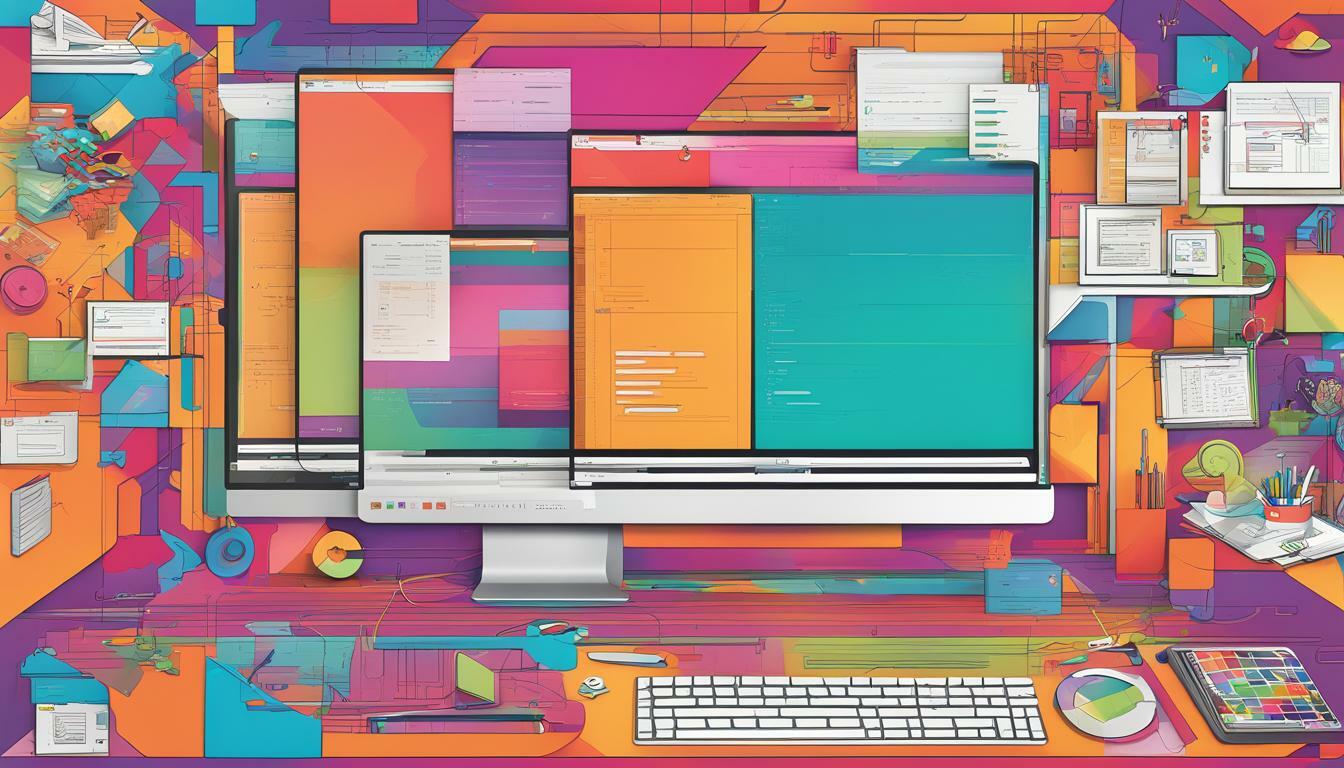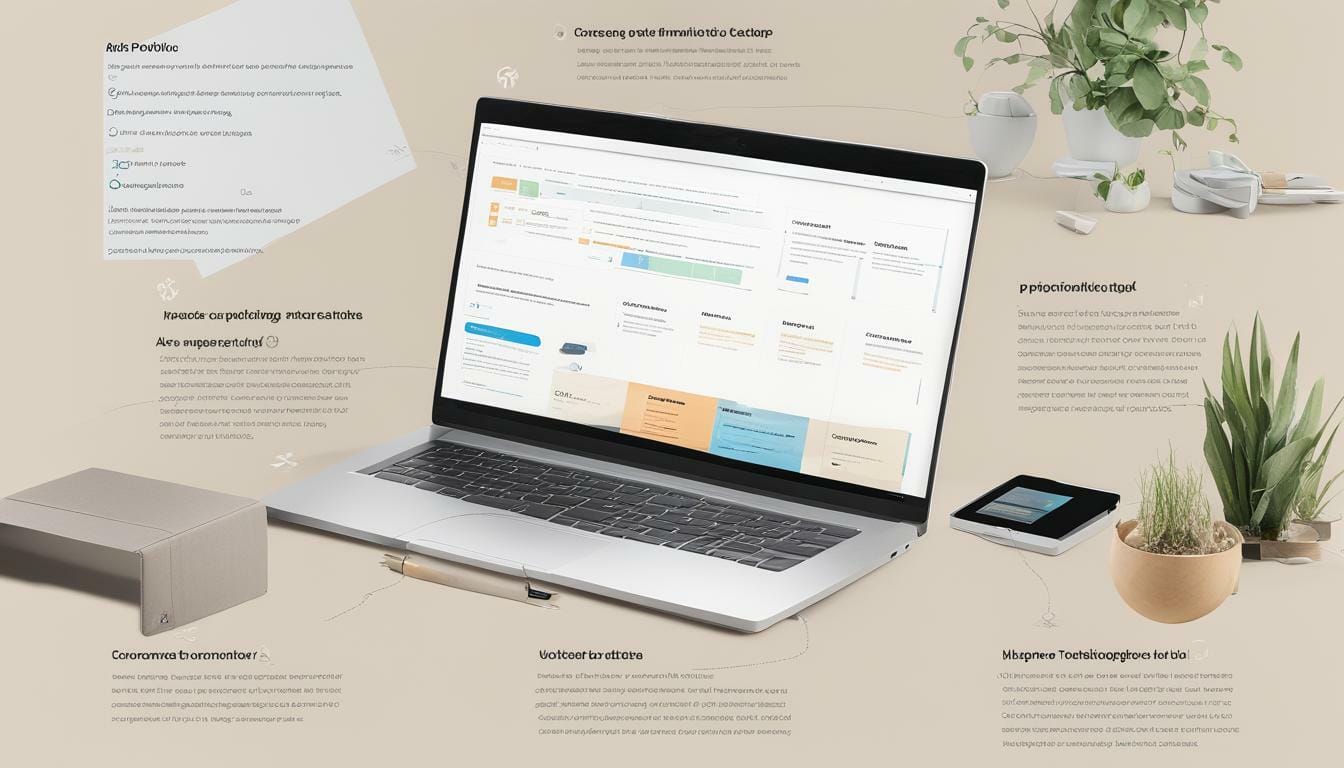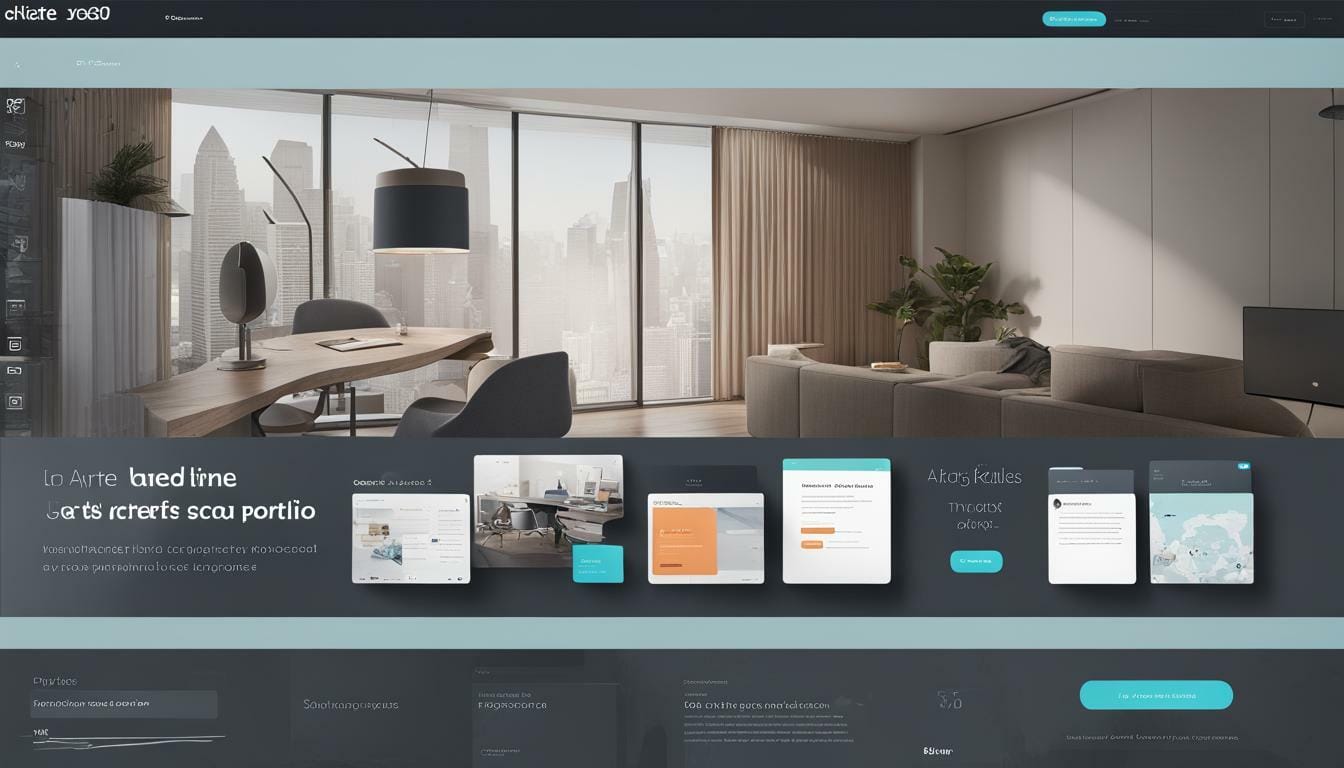Mastering the Art: Creating a Coding Portfolio Made Simple

If you’re a programmer aiming to progress in your career and showcase your skills to prospective employers, it is crucial to develop a coding portfolio. A meticulously crafted portfolio doesn’t just affirm your technical competence, but also emphasizes your innovative thinking, problem-solving aptitude, and collaborative abilities. In this piece, I will offer advice and present the top tactics recommended by the industry for constructing a stand-out coding portfolio that will set you apart in the cutthroat job market.
Key Takeaways
- Creating a coding portfolio is crucial for aspiring programmers to showcase their skills and impress potential employers.
- Setting clear goals for the portfolio, selecting relevant coding projects, and tailoring it to your target audience are important best practices.
- Choosing the right platform, showcasing technical skills effectively, and highlighting accomplishments can further enhance the portfolio’s effectiveness.
- Regularly maintaining and updating the portfolio and seeking feedback can help improve its quality over time.
- In addition to technical skills, showcasing soft skills such as collaboration, communication, and problem-solving can be valuable for success in the field.
Why Create a Coding Portfolio?
Building a programming portfolio is a crucial step for any aspiring programmer. A well-crafted portfolio allows you to showcase your coding projects and demonstrate your technical skills to potential employers. By including a variety of coding projects, you can demonstrate your versatility and expertise in different programming languages and technologies.
Creating a coding portfolio is also an opportunity to showcase your problem-solving abilities. By highlighting the challenges you faced during a project and the solutions you implemented, you can demonstrate your ability to think critically and creatively. This is particularly important for positions that involve developing innovative solutions.
Without a coding portfolio, it can be difficult to stand out in a competitive job market. A portfolio allows you to differentiate yourself from other candidates and provides employers with tangible evidence of your skills and abilities. By showcasing your coding projects, you can demonstrate your passion for programming and commitment to continuous learning.
In addition to impressing potential employers, a coding portfolio can also help you land freelance or independent contractor work. By showcasing your past projects and accomplishments, you can market your skills and expertise to clients. This can be particularly valuable for programmers who are just starting their careers and are looking to build a client base.
In short, creating a coding portfolio is a valuable investment in your career as a programmer. It allows you to showcase your technical skills, problem-solving abilities, and passion for programming to potential employers and clients. By building a portfolio that effectively demonstrates your capabilities, you can position yourself for success in a competitive job market.

Setting Clear Goals
When creating a coding portfolio, it’s crucial to set clear goals to guide your project selection and presentation. Best practices for coding portfolio projects include showcasing a range of skills and implementing coding projects that are relevant to your goals.
One of the most effective coding portfolio best practices is to tailor your portfolio to your target audience. If you’re looking for work in a specific niche, such as frontend development or mobile app development, be sure to include coding projects that demonstrate your expertise and experience in that area.
Diversity is also important when it comes to selecting coding portfolio projects. Try to include a range of projects that showcase different programming languages, tools, and techniques. This not only demonstrates your versatility and adaptability as a programmer but also shows potential employers that you are up-to-date with emerging technologies.
When selecting coding portfolio projects, it’s important to be realistic about what you can accomplish given your available time and resources. Focus on creating a polished, effective coding portfolio rather than building a lengthy list of projects that are incomplete or poorly executed.
Finally, be sure to research coding portfolio examples and seek feedback from other experienced programmers. Iterating on your portfolio will help you refine your presentation and ensure that you’re showcasing the best possible version of your coding skills and accomplishments.
Choosing the Right Platform
When it comes to showcasing your coding portfolio, choosing the right platform is crucial. There are numerous platforms available, each with their own strengths and weaknesses. Some popular options include:
| Platform | Pros | Cons |
|---|---|---|
| GitHub Pages | – Free and easy to use – Integrates with GitHub repositories |
– Limited customization options – May not be suitable for non-GitHub projects |
| Codepen | – Built for showcasing coding projects – Social features for networking and feedback |
– Limited functionality beyond small projects – May be less professional than other platforms |
| Squarespace | – Wide range of customization options – Professional and polished look |
– More expensive than other options – May require more technical knowledge to set up |
When choosing a platform, consider factors such as design, functionality, ease of use, and compatibility with your coding projects. Take a look at coding portfolio examples on each platform to see what works best for your needs. Remember, the goal is to showcase your coding skills and projects in the best possible light.

Showcasing Technical Skills
When it comes to creating a coding portfolio, one of the most important aspects is demonstrating technical skills. As a programmer, your technical abilities are what set you apart from the competition, so it’s crucial to highlight them effectively. Here are some tips for showcasing your technical skills in your coding portfolio:
Organize Your Projects
Organizing your projects in a logical way is key to showcasing your technical skills. Group projects by programming language, type, or complexity level. This will allow potential employers to quickly identify your strongest areas of expertise and assess your suitability for specific roles.

Highlight Your Best Work
Choose your best projects to include in your portfolio. These should be the projects that demonstrate your technical skills most effectively, and that you are most proud of. Be sure to include a variety of projects that show your range as a programmer.
Provide Context
Provide context for your projects by explaining their purpose, the specific technical challenges you faced, and how you overcame them. This will give potential employers a better understanding of your skills and how you apply them.
Include Code Samples
Include code samples in your portfolio to demonstrate your technical skills in action. This will also give potential employers a better sense of the quality of your code and how you approach coding challenges.
By following these tips, you can effectively showcase your technical skills in your coding portfolio. Demonstrating your technical abilities is essential for standing out in the competitive job market and securing your ideal programming role.
Highlighting Accomplishments
When building a coding portfolio, it’s essential to not only showcase coding skills but to also highlight accomplishments and the impact of coding projects. Effective coding portfolios go beyond just displaying code, demonstrating the value and results that a programmer can bring to potential employers or clients.
One way to highlight accomplishments is by using metrics and tangible outcomes. For example, if a coding project resulted in a significant increase in website traffic or sales, including specific numbers and percentages can help demonstrate the impact of the project. Another way to showcase accomplishment is by highlighting the challenges and obstacles faced during the project, as well as the solutions implemented to overcome them.
It’s also important to tailor the projects included in the coding portfolio to specific career goals. For instance, if a programmer wants to work in the healthcare industry, including projects that involve medical applications or data analysis in that field can help demonstrate relevant experience and expertise. Including a variety of projects that showcase a range of skills and demonstrate versatility can also be effective in creating a well-rounded and impressive portfolio.

Ultimately, highlighting accomplishments in a coding portfolio is about demonstrating the value and expertise that a programmer can bring to potential employers. By showcasing the impact and results of coding projects, programmers can stand out and show that they are more than just skilled coders, but valuable assets to any team or project.
Writing Engaging Project Descriptions
When creating a coding portfolio, writing project descriptions is just as important as showcasing the projects themselves. Effective descriptions can provide context for your work, communicate your thought process, and demonstrate your problem-solving skills. Here are some best practices for writing engaging project descriptions:
1. Keep it concise
While you want to provide enough detail about your project, it’s important to keep your description concise. Aim for 2-3 paragraphs that highlight the most important aspects of your work. Use bullet points or numbered lists to make your description more skimmable. Remember, hiring managers are often short on time, so make sure your description is easy to scan.
2. Tell a story
Use your project description as an opportunity to tell a story about your work. Start by introducing the problem you were trying to solve, and then explain your approach. Talk about the challenges you faced and how you overcame them. Finally, describe the outcome of your project and any metrics you used to measure success. A well-crafted story can help you stand out from other candidates and make your portfolio more memorable.
3. Use technical language, but avoid jargon
It’s important to use technical language in your project description to demonstrate your expertise. However, be careful not to use too much jargon or acronyms that may not be familiar to the reader. If you must use a technical term, make sure you define it clearly.
4. Highlight your problem-solving skills
Focus on the problem-solving process in your project description, rather than just the code itself. Explain how you approached the problem, the decisions you made, and any trade-offs you had to consider. This will demonstrate your ability to think critically and solve complex problems.
5. Use visuals to enhance your description
Consider using screenshots or diagrams to illustrate your project in action. This can help the reader understand your work more easily and make your portfolio more visually appealing. Just be sure to keep your visuals relevant and use them sparingly.
By following these best practices, you can create project descriptions that showcase your problem-solving skills and make your portfolio more engaging and memorable.

Incorporating Visuals and Design
Visuals and design play a crucial role in creating an effective coding portfolio. They can enhance the overall presentation of coding projects and make the portfolio more engaging for potential employers to browse. Here are some tips for incorporating visuals and design into your coding portfolio:
- Use screenshots or videos to showcase your coding projects in action. This will help potential employers better understand your work and its functionality. Make sure the visuals are high quality and relevant to the project description.
- Consider adding infographics or charts to illustrate the impact and results of your coding projects. These visuals can provide a quick snapshot of your accomplishments and make your portfolio more memorable.
- Choose a clean and professional design for your portfolio. Avoid using flashy graphics or fonts that may distract from your work. Keep the layout simple and easy to navigate for potential employers.
When it comes to visuals and design, remember that less is often more. You want to showcase your coding projects and skills, not overwhelm potential employers with flashy graphics. Take a minimalist approach and let your work speak for itself.

Seeking Feedback and Iterating
One of the most crucial coding portfolio best practices is to continuously seek feedback and iterate on your portfolio. As you build and refine your portfolio, it is important to gather constructive feedback from trusted sources to improve its effectiveness. This feedback can come from mentors, peers, or even potential employers.
An effective way to gather feedback is to test your portfolio on a small group of individuals and ask for their honest opinions. You can also share your portfolio with online communities or blogs to receive valuable input. Feedback can help you identify areas of improvement and refine your portfolio to better showcase your skills and accomplishments.
It is also important to keep your portfolio up-to-date as you continue to build skills and work on new projects. Consider adding new projects, updating project descriptions, and incorporating new technologies or skills you have learned to keep your portfolio fresh and relevant.
Remember, a coding portfolio is a living document that should reflect your growth and progress over time. By seeking feedback and iterating on your portfolio, you can ensure it always presents your best work and accurately reflects your skills and expertise.

Showcasing Soft Skills
While technical skills are essential for any coding portfolio, it’s equally important to showcase your soft skills. In addition to highlighting your collaboration, communication, and problem-solving abilities, you should also emphasize your ability to work well with others, adapt to new situations, and think critically.
One effective way to showcase your soft skills is by including group projects in your portfolio. When describing these projects, be sure to focus on your contributions to the team and how you worked with others to achieve the project’s goals. You should also highlight any leadership roles you held and examples of how you effectively managed and motivated others.
Another way to demonstrate your soft skills is by incorporating testimonials or feedback from colleagues or clients into your portfolio. Highlighting positive comments and ratings you’ve received can help bolster your credibility and demonstrate your ability to work well with others.
Finally, don’t overlook the importance of clear and concise communication in your portfolio. Make sure your project descriptions and explanations are easy to understand and free of technical jargon. By showcasing your ability to clearly communicate complex concepts, you’ll demonstrate your value to potential employers and clients.

What Are Some Best Practices for Collaborating on Coding Projects?
When collaborating on coding projects, it is crucial to adhere to pull request best practices. Creating clear and concise pull requests, providing comprehensive documentation, and soliciting feedback from team members are some essential aspects to ensure smooth collaboration. It is important to review and discuss each pull request thoroughly, addressing any bugs or issues promptly. By following these best practices, team members can collaborate effectively and enhance the quality of their coding projects.
Maintaining and Updating the Portfolio
Keeping your coding portfolio up to date is just as important as creating it. Regularly adding new projects, updating your skills, and showcasing your latest accomplishments can help you stay relevant and make a lasting impression on potential employers.
One of the best practices for maintaining your coding portfolio is to set a recurring reminder to update it every few months. This will help ensure that you don’t forget to showcase important projects and skills that you’ve developed since your last update.
When updating your portfolio, be sure to focus on quality over quantity. Instead of adding every project you’ve ever worked on, carefully choose the ones that best demonstrate your skills and experience.
In addition to adding new projects, it’s also important to update your portfolio with any new skills or certifications you’ve earned. This can help show potential employers that you’re committed to continuous learning and growth in the field.
Regularly seeking feedback and iterating on your portfolio can also help you stay ahead of the curve. Consider asking peers, mentors, or even professional recruiters for their thoughts on your portfolio, and use their feedback to make any necessary improvements.
Finally, be sure to showcase ongoing growth and learning in your portfolio. This can include attending workshops or conferences, participating in hackathons, or even contributing to open-source projects. By continuously adding new projects and skills to your portfolio, you can demonstrate your passion for coding and commitment to becoming a top-notch programmer.

By following these best practices for maintaining and updating your coding portfolio, you can ensure that it remains a powerful tool for showcasing your skills and impressing potential employers.
Conclusion
Creating a coding portfolio may seem daunting, but it is an essential step towards establishing a successful career in the programming field. By showcasing your coding projects, you demonstrate your technical skills, problem solving abilities, creativity, and value to potential employers or clients.
Throughout this article, I have provided guidance on building a programming portfolio that effectively showcases your skills and accomplishments. From setting clear goals and choosing the right platform to showcasing technical skills and soft skills, there are many best practices to consider when creating a coding portfolio.
To summarize, remember to:
Set Clear Goals
Select coding portfolio projects that are relevant, diverse, and tailored to your career goals and target audience.
Choose the Right Platform
Select coding portfolio examples and platforms that fit your design and functionality preferences.
Showcase Technical Skills
Organize and present coding projects to demonstrate proficiency and expertise in various coding skills.
Highlight Accomplishments
Emphasize the impact and results of coding projects, using metrics and tangible outcomes to showcase your value.
Write Engaging Project Descriptions
Communicate the goals, challenges, and solutions of coding projects in clear and concise language while showcasing creativity and problem-solving skills.
Incorporate Visuals and Design
Use screenshots, videos, and other visual elements to enhance the presentation of coding projects and create a visually appealing and user-friendly portfolio design.
Seek Feedback and Iterate
Gather constructive feedback and continuously refine your portfolio to enhance its effectiveness and stay relevant.
Showcase Soft Skills
Highlight collaboration, communication, problem-solving, and other non-technical skills that are important for success in the field.
Maintain and Update the Portfolio
Regularly add new projects, skills, and accomplishments to keep your portfolio up to date and showcase ongoing growth and learning.
By implementing these tips and best practices, you will be well on your way to creating an effective coding portfolio that impresses potential employers and clients. So what are you waiting for? Start building your portfolio today!
FAQ
Q: Why is creating a coding portfolio important?
A: Creating a coding portfolio is important because it allows you to showcase your coding projects and demonstrate your skills to potential employers. It helps you stand out in the competitive job market and impress recruiters with your technical abilities.
Q: How do I set clear goals for my coding portfolio?
A: To set clear goals for your coding portfolio, you should consider what you want to achieve with your portfolio and who your target audience is. Select coding projects that align with your career goals and demonstrate your expertise. Aim for diversity and relevancy in your portfolio to showcase a range of skills.
Q: Which platform should I choose to showcase my coding portfolio?
A: There are many platforms available to showcase your coding portfolio. Some popular options include GitHub Pages, WordPress, and Behance. Choose a platform that aligns with your design preferences and offers the functionality you need. Consider ease of use and the ability to customize your portfolio for the best showcase of your work.
Q: How can I effectively showcase my technical skills in my coding portfolio?
A: To effectively showcase your technical skills in your coding portfolio, organize and present your projects in a logical and structured manner. Highlight the technologies, languages, and frameworks you used in each project. Include code snippets, screenshots, and live demos to demonstrate your proficiency. You can also provide explanations of the technical challenges you faced and how you overcame them.
Q: How do I highlight my accomplishments in my coding portfolio?
A: To highlight your accomplishments in your coding portfolio, focus on the impact and results of your coding projects. Quantify the outcomes using metrics and tangible evidence. Describe the problems you solved and the value you brought to the project. This will demonstrate the value you can bring to potential employers or clients.
Q: How do I write engaging project descriptions in my coding portfolio?
A: When writing project descriptions in your coding portfolio, be clear, concise, and descriptive. Communicate the goals, challenges, and solutions of each project in a way that engages the reader. Use a storytelling approach to showcase your creativity and problem-solving skills. Highlight the benefits and unique aspects of your project.
Q: How important is the visual design of my coding portfolio?
A: The visual design of your coding portfolio plays a significant role in making a positive impression on potential employers or clients. Incorporate visually appealing elements such as screenshots, videos, and other multimedia to enhance the presentation of your coding projects. Ensure your portfolio design is user-friendly and easy to navigate.
Q: Should I seek feedback and iterate on my coding portfolio?
A: Yes, seeking feedback and iterating on your coding portfolio is essential for continuous improvement. Share your portfolio with peers, mentors, or industry professionals and gather constructive feedback. Use this feedback to make necessary improvements and refine your portfolio. Regularly update your portfolio to showcase your latest projects and skills.
Q: How can I showcase my soft skills in my coding portfolio?
A: In addition to technical skills, it’s important to showcase your soft skills in your coding portfolio. Highlight your collaboration, communication, problem-solving, and other non-technical skills that are relevant to the field. Provide examples and anecdotes that demonstrate your ability to work well in a team and handle challenges effectively.
Q: How do I maintain and update my coding portfolio?
A: To maintain and update your coding portfolio, make a habit of regularly adding new projects, skills, and accomplishments. Keep your portfolio up to date with the latest technologies and trends in the industry. Showcase ongoing growth and learning by continually improving and expanding your portfolio.






